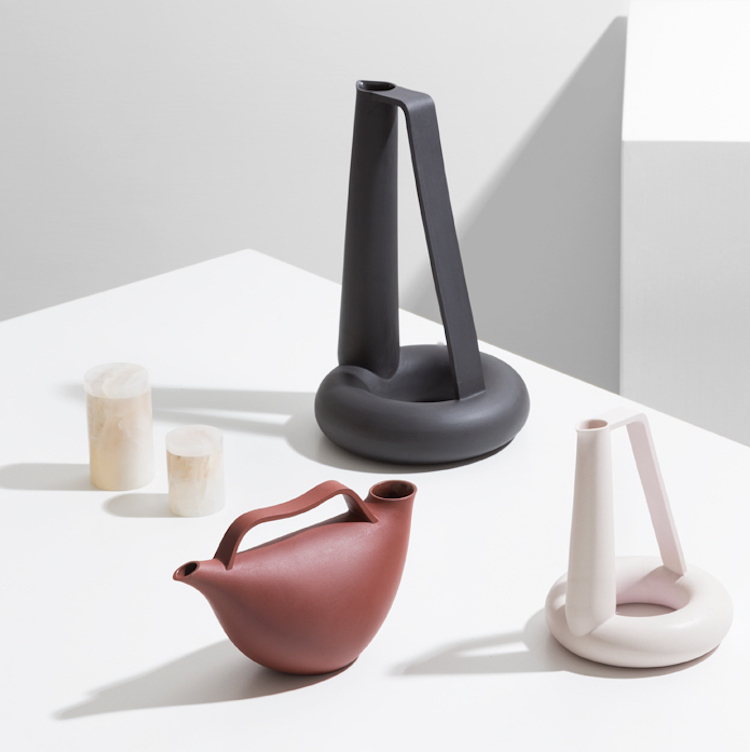AMSTERDAM, The Netherlands — About a week ago we brought you the story of “Last of the Free,” a design series by Nick Ross that cleverly draws attention to the different lenses through which we view history. In that set, Ross attempted to make modern recreations of ancient Scottish home furnishings, but his only source for these were old Roman histories of the region, which were, of course, biased. He compensated for that fact by giving each design a slightly “Romanized” look. Through objects, Ross was able to illustrate an important and sometimes hard to explain concept about history.
Above Image: Acquedotto I, II and III, 2016, all porcelain. Part of Studio Formafantasma’s “Delta” series for Design Miami/ Basel.
The designers we have for you today, Studio Formafantasma, are also playing within the realm of Roman history, but they’re a little more auspicious. Their “Delta” series, designed in collaboration with the Roman Design Gallery Giustini and Stagetti Galleria O. Roma and curated by Domitilla Dardi of the Maxxi in Roma, takes a different view of history, this one through an evolutionary lens. The studio states that they were inspired by the delta in the river Tiber, the main watercourse of Rome. The studio explains that the delta of a river is a landform that forms deposits of silt and debris carried by water over many, many years.
This suggests a layering effect, but why? Well, after visiting various architectural sites in the region and falling in love with what could be considered typical or even mundane ancient furnishings, the designers became fascinated by elements of those designs that seem contemporary by today’s standards. The studio explains:
The designers have been particularly attracted by very mundane objects of the Imperial Rome and while some artifacts shown in the museums have served as inspiration, others have been directly sampled and carefully updated for the contemporary use. In the case of the porcelain pieces for instance the designers decided to change as little as possible in the forms and even the chosen colors are a very clear reference to the history of Roman pottery.
But is it that the designs seem contemporary or is it that classic design is buried deep within the DNA of objects we have today? Are we looking at trends or are we looking at heritage? These are difficult (if not impossible) questions to answer, but that’s the fun of history. Despite all of the dates you had to learn through rote memorization in school, history can be very subjective. We have evidence of what happened and when, but such evidence can be read in a variety of ways. With these pieces of furniture, lighting fixtures and tableware we have the suggestion of an absolute, but whether that absolute exists or whether it’s plain ol’ confirmation bias is up to the viewer to decide. We have another philosophical discussion about history and it’s supremely cool that it is presented to us entirely through objects.
There’s a commitment to historical certainty, where the designers were able to find it. They note that in contrast to contemporary standards, red and black ceramics shared a millennium of popularity in ancient times. Therefore, one of the anachronisms in the set is a very subtle off-white color.
The set was on display at this year’s Design Miami/ Basel.
Studio Formafantasma is a partnership between Italian designers Andrea Trimarchi (b. 1983) and Simone Farresin (b. 1980), according to their biography. The duo attended Design Academy Eindhoven, where they graduated in 2009. As we learned above, much of their practice is based in research that questions the link between tradition and local culture. Their work has been presented and published internationally and museums such as New York’s MoMA, London’s Victoria and Albert, New York’s Metropolitan Museum, the Chicago Art Institute, the Textiel Museum in Tilburg, the Stedelijk’s-Hertogenbosch, MUDAC Lausanne, the Mint Museum of Craft and Design in North Carolina and the Mak Museum in Vienna have all acquired Formafantasma’s designs for their permanent collections. The two work out of Amsterdam today.
Bill Rodgers is the Managing Editor of cfile.daily.
Do you love or loathe this use of contemporary ceramics? Let us know in the comments.






Add your valued opinion to this post.